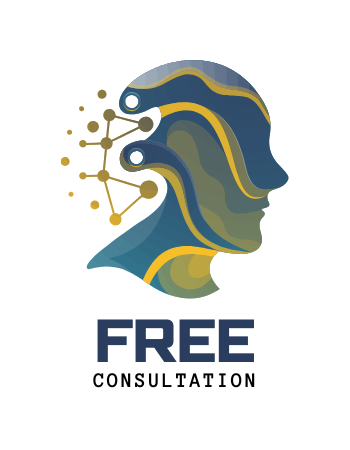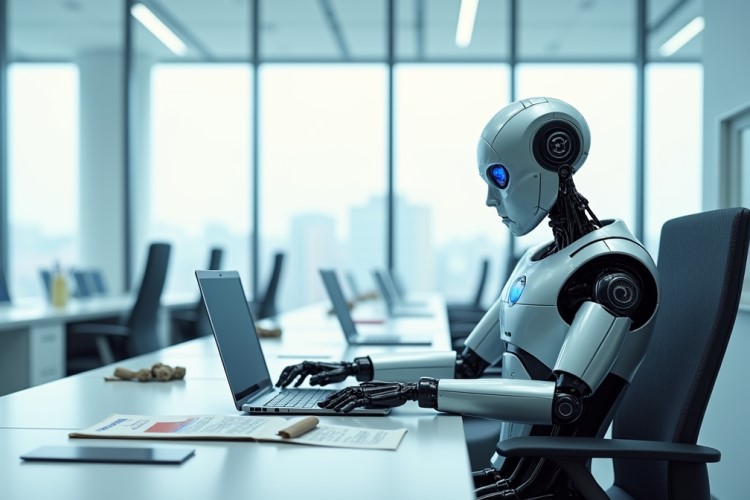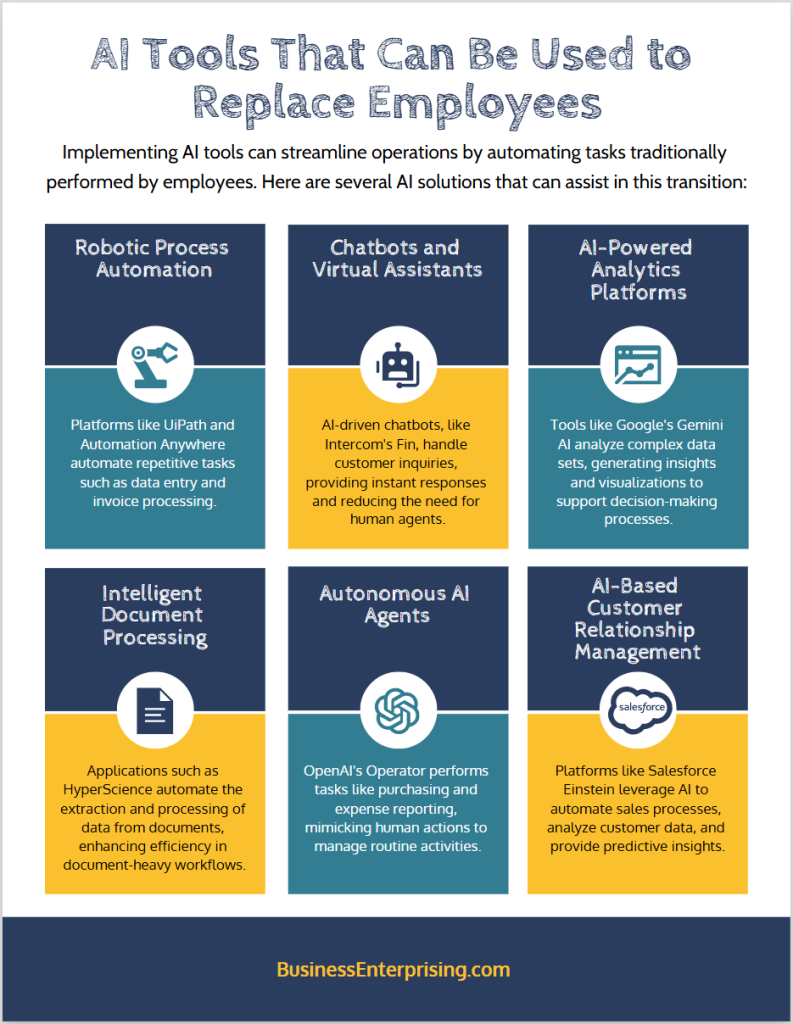 Integrating artificial intelligence (AI) into operations has become a focal point for many organizations. Understanding how to replace employees with AI involves a strategic approach. By carefully assessing which tasks can be automated, selecting appropriate AI tools, and planning for workforce transitions, you can harness AI’s potential to enhance efficiency and drive innovation within your company.
Integrating artificial intelligence (AI) into operations has become a focal point for many organizations. Understanding how to replace employees with AI involves a strategic approach. By carefully assessing which tasks can be automated, selecting appropriate AI tools, and planning for workforce transitions, you can harness AI’s potential to enhance efficiency and drive innovation within your company.
Identifying Tasks Suitable for Automation
When considering how to replace employees with AI, it’s important to identify tasks suitable for automation. Focus on repetitive, rule-based tasks that AI can handle efficiently. For example, data entry, invoice processing, and scheduling are ideal candidates. These tasks follow predictable patterns, making them easier for AI to manage.
Additionally, analyze job functions that require minimal human interaction. Tasks like generating standard reports or monitoring systems can be automated. By automating these functions, you free up employees to focus on more complex responsibilities. This shift enhances productivity and allows your team to engage in higher-value work.
However, not all tasks are suitable for AI automation. Jobs involving creativity, complex decision-making, or nuanced human interaction may still require a human touch. Therefore, it’s important to assess each task’s characteristics before deciding to automate. By carefully evaluating your operations, you can implement AI where it adds the most value.
Evaluating AI Solutions and Tools
When considering how to replace employees with AI, it’s important to evaluate various AI solutions and tools. Robotic Process Automation (RPA) excels at automating repetitive, rule-based tasks. For instance, RPA can handle data entry and invoice processing efficiently. However, it lacks the ability to learn or adapt to new scenarios.
Chatbots, on the other hand, provide automated customer interactions. They can answer common inquiries and guide users through processes. While chatbots enhance customer service availability, they may struggle with complex or nuanced questions. Therefore, they are best suited for straightforward interactions.
Machine learning offers more advanced capabilities. It analyzes data patterns to make informed decisions. This technology can improve over time as it learns from new data. For example, machine learning algorithms can predict customer behavior or detect fraudulent activities. However, implementing machine learning requires substantial data and expertise.
Selecting the right AI tools depends on your specific business needs. Assess the tasks you aim to automate and determine which technology aligns best. Additionally, consider the complexity of implementation and the resources available. By carefully matching AI solutions to your requirements, you can effectively integrate automation into your operations.
Addressing Workforce Transition and Reskilling
When considering how to replace employees with AI, it’s important to address workforce transition and reskilling. Developing strategies to transition employees to new roles is essential. By identifying tasks suitable for automation, you can reassign staff to areas requiring human expertise. This approach maintains engagement and leverages existing talent.
Implementing reskilling programs equips workers with new skills. Providing training in AI-related competencies prepares employees for evolving roles. For instance, offering courses in data analysis or AI system management can be beneficial. Additionally, fostering a culture of continuous learning encourages adaptability. Therefore, investing in employee development supports a smoother transition.
Moreover, clear communication about AI integration alleviates concerns. Transparency regarding the implementation process helps build trust. By involving employees in discussions, you can address apprehensions effectively. This inclusive approach promotes acceptance and collaboration. Consequently, your organization can navigate the shift towards AI more successfully.
Calculating Cost-Benefit Analysis of AI Implementation
When considering how to replace employees with AI, conducting a thorough cost-benefit analysis is essential. Begin by estimating the initial investment required for AI implementation. This includes expenses for software acquisition, hardware infrastructure, and integration into existing systems. Additionally, account for ongoing maintenance costs, such as system updates and technical support. Training employees to work with new AI tools also contributes to these expenses.
However, the potential long-term savings can be substantial. AI can automate repetitive tasks, leading to increased efficiency and reduced labor costs. For example, automating data entry can free up employees for more strategic roles. Moreover, AI systems can operate continuously without fatigue, enhancing productivity. Therefore, the initial costs may be offset by these long-term benefits.
Nevertheless, it’s important to weigh these financial benefits against potential challenges. Implementing AI may encounter technical difficulties, requiring additional resources to address. There could also be resistance from employees concerned about job displacement. Furthermore, ongoing maintenance and updates are necessary to keep AI systems effective. By carefully evaluating both the advantages and challenges, you can make an informed decision about AI adoption.
Managing Change and Employee Engagement
When considering how to replace employees with AI, managing change and maintaining employee engagement are essential. Effective communication plays a pivotal role in this process. Clearly articulating the reasons for AI integration helps employees understand its benefits. This transparency reduces uncertainty and fosters trust. Additionally, involving employees in discussions about AI adoption encourages a sense of ownership. By seeking their input, you demonstrate respect for their perspectives. This inclusivity can lead to smoother transitions and greater acceptance of new technologies.
Addressing employee concerns is equally important. Many workers fear that AI will render their roles obsolete. To alleviate these anxieties, provide clear information about how AI will impact specific tasks. Offering reskilling opportunities can also reassure employees. By investing in their development, you show a commitment to their future within the organization. This approach not only maintains morale but also enhances the overall skill set of your workforce.
Maintaining employee morale during the transition requires ongoing support. Regular updates about AI implementation progress keep everyone informed. Celebrating small milestones acknowledges collective efforts and boosts morale. Furthermore, providing platforms for employees to voice their concerns and ask questions fosters an open culture. By actively listening and responding, you reinforce trust and engagement. This proactive approach ensures that the shift towards AI integration is collaborative and positive.
Monitoring and Optimizing AI Performance
When considering how to replace employees with AI, it’s important to monitor and optimize AI performance. Establishing clear metrics is essential to evaluate effectiveness. For instance, accuracy measures how often AI produces correct results. Additionally, precision and recall assess the relevance of AI outputs. These metrics help you understand AI’s performance in specific tasks.
However, monitoring alone isn’t sufficient. You must continuously refine AI processes based on performance data and feedback. Regularly reviewing metrics allows you to identify areas needing improvement. By adjusting algorithms or retraining models, you can enhance accuracy and efficiency. Therefore, ongoing optimization ensures AI remains effective and aligned with your business goals.
Moreover, incorporating user feedback provides valuable insights. Employees interacting with AI systems can offer practical observations. By considering their input, you can make targeted improvements. This collaborative approach fosters a smoother integration of AI into your operations. Consequently, both AI performance and employee satisfaction can improve.
Conclusion
Implementing AI to replace employees requires careful planning and execution. By identifying suitable tasks for automation, evaluating appropriate AI solutions, and developing reskilling programs, you can facilitate a smooth transition. Additionally, conducting a thorough cost-benefit analysis and establishing clear performance metrics will help optimize AI integration. By addressing these aspects thoughtfully, you can harness AI’s potential to enhance efficiency and drive innovation within your organization.






